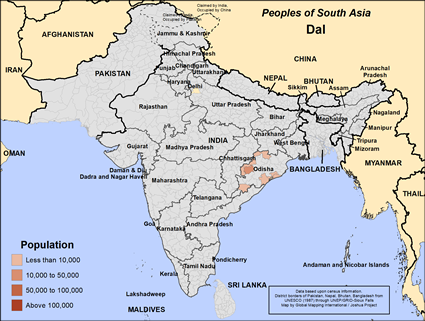Dal in India

Send Joshua Project a photo
of this people group. |

Map Source:
People Group data: Omid. Map geography: UNESCO / GMI. Map Design: Joshua Project
|
| People Name: | Dal |
| Country: | India |
| 10/40 Window: | Yes |
| Population: | 26,000 |
| World Population: | 26,000 |
| Primary Language: | Odia |
| Primary Religion: | Hinduism |
| Christian Adherents: | 0.12 % |
| Evangelicals: | 0.00 % |
| Scripture: | Complete Bible |
| Ministry Resources: | Yes |
| Jesus Film: | Yes |
| Audio Recordings: | Yes |
| People Cluster: | South Asia Tribal - other |
| Affinity Bloc: | South Asian Peoples |
| Progress Level: |
|
Introduction / History
The Dal come from Odisha and are a scheduled tribe, which means they have the low status of a tribe in Hindu society. They get their name from moving villages and speak Kui and Oriya.
What Are Their Lives Like?
They work as agricultural and as forest laborers. Women help by collecting firewood and forest produce. The Dal are monogamous. The bereaved and divorced can marry again. The dead are buried and the sons share the property. The Dal have a council to look after their interests. They have a low literacy level, so the gospel will need to be given in oral forms as well.
What Are Their Beliefs?
The Dal people practice Hinduism, the ancient religion of India. Hinduism is a catch-all phrase for the local religions of South Asia, so it is very diverse. At the popular level, Hindus worship and serve the gods of the Hindu pantheon. They visit Hindu temples and offer prayers, food, flowers, and incense to their gods in hopes of gaining protection and benefits. They do not have a personal or familial relationship with their gods like Christians or Jews. There are other Hindus who are much more philosophical, especially among the Brahmins.
What Are Their Needs?
The Dal people need the abundant blessings of Jesus Christ. They also need to find better ways to earn a living.
Prayer Points
Pray that family heads and council leaders come to Jesus Christ and lead their community to the Savior. Pray for spiritual openness to the claims of Christ. Pray for workers and intercessors.